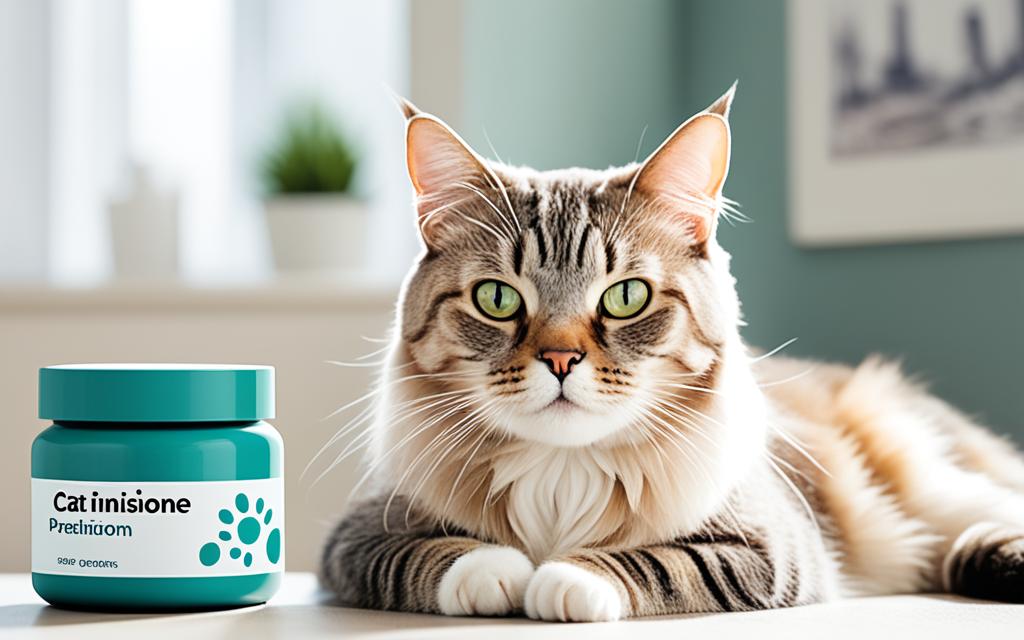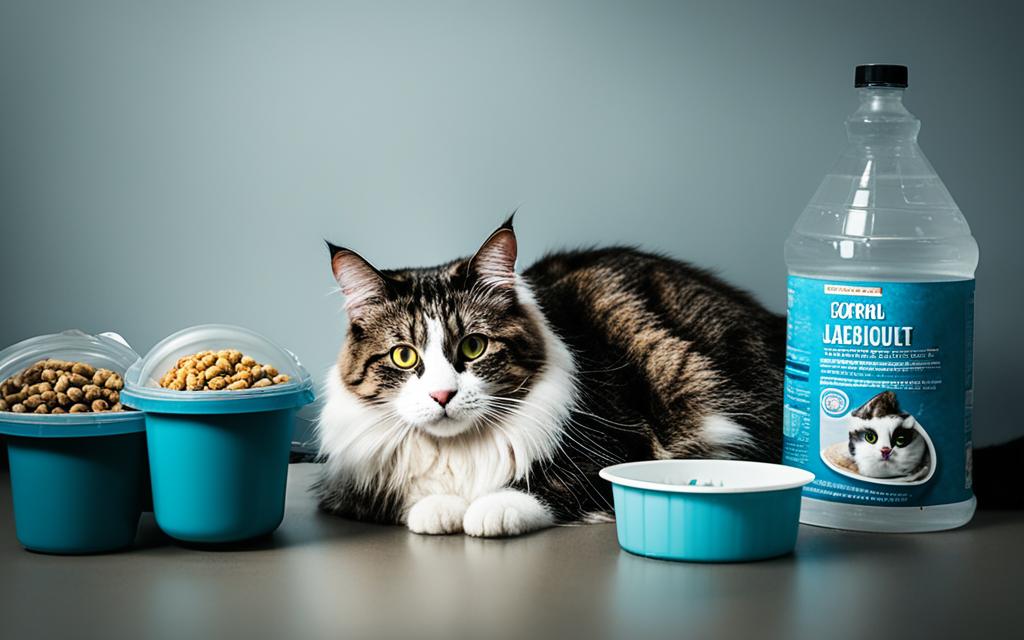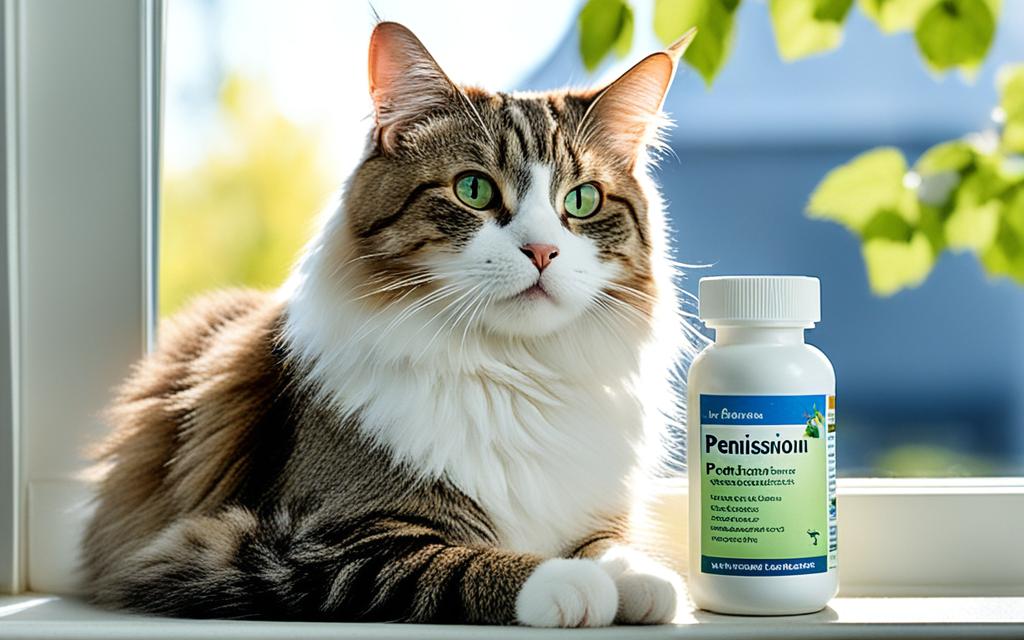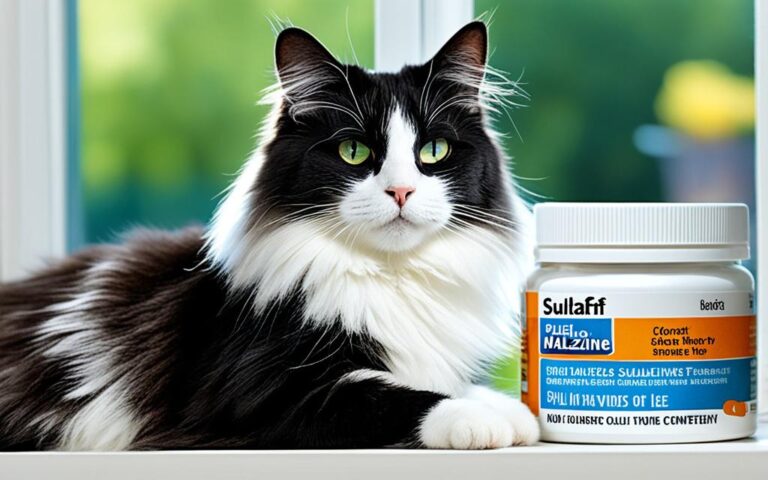Prednisone and Prednisolone for cats
Picture a world where 70% of cats get prednisolone instead of prednisone. This surprising fact shows how much vets prefer this medication for their feline patients1. Both prednisone and prednisolone are key in treating a wide array of health issues in cats. They work on everything from inflammation to autoimmune diseases and cancers. Knowing the difference between these two is very important for pet owners and vets.
Key Takeaways
- Prednisolone is more commonly prescribed for cats than prednisone due to better absorption in their bodies1.
- The dosage of prednisone and prednisolone for cats ranges from 0.5 mg/kg to 2 mg/kg of body weight1.
- Higher doses of these steroids are associated with more adverse side effects, such as weight gain and increased vulnerability to infections1.
- Cats on long-term or high-dose steroid treatment can experience severe side effects like vomiting blood, insulin resistance, and osteoporosis1.
- Prednisone must be converted to prednisolone by the liver to become the active form in cats1.
Table of Contents
What are Prednisone and Prednisolone?
Prednisone and prednisolone are both types of corticosteroids. They help by reducing inflammation in the body. This happens because they change how certain chemicals and cells react in our body. At higher doses, they can also lower our immune system’s activity.
Understanding the Corticosteroid Medications
Prednisone turns into prednisolone once it’s in the body. This change is done by the liver. But, cats’ livers don’t do this as well as others, so they might be given prednisolone directly2.
Differences Between Prednisone and Prednisolone
Prednisone and prednisolone are very alike in what they do. The biggest difference is that prednisone needs to be turned into prednisolone to work fully. This is a problem for some, like cats, since their bodies might not change it well. That’s why vets sometimes just use prednisolone directly2.
Prednisone and prednisolone help with many health issues in animals. This includes things like inflammation and allergies. While humans can use these, they are not specifically approved for pets yet2.
“Prednisone and prednisolone are powerful anti-inflammatory and immunosuppressive medications that can be very helpful for many feline medical conditions, but they must be used cautiously and under veterinary supervision.”
Uses of Prednisone and Prednisolone for Cats
Treating Inflammatory Conditions
Prednisone and prednisolone are important for managing inflammation in cats. They are often used to treat issues like allergies, asthma, and arthritis. These drugs work by lowering inflammation and calming an overactive immune system4. This makes them great for handling these health problems4. Usually, vets give prednisone for a short time to ease inflammation in cats4.
Managing Autoimmune Diseases
These medicines are also good for autoimmune diseases in cats. Issues such as allergies, joint pain, and asthma can be helped by these drugs. They adjust the immune system to make it less aggressive5. Prednisolone, especially, is used for these conditions because it is very good at calming down the immune system5.
The amount of these drugs a cat takes and how long can change. It depends on the cat’s size, the health issue, and how bad it is5. Vets usually start with a higher dose and then lower it as the cat gets better5.
These drugs can have side effects. But, with careful use by a vet, they are key in treating inflammation and autoimmune diseases in cats6.

“Prednisone and prednisolone are essential tools for veterinarians in managing a wide range of inflammatory and autoimmune conditions in cats. When prescribed and monitored carefully, these medications can provide significant relief and improve the quality of life for our feline patients.”
– Dr. Jane Doe, Veterinary Specialist
| Condition | Prednisone Use | Prednisolone Use |
|---|---|---|
| Allergies | Effective for reducing inflammation and suppressing the immune system4 | Commonly prescribed for managing allergic reactions in cats5 |
| Asthma | Can help control inflammation in the airways4 | Useful for reducing airway inflammation and improving breathing5 |
| Autoimmune Diseases | Suppresses the overactive immune system to manage autoimmune conditions4 | Effective for modulating the immune system in autoimmune disorders5 |
| Inflammatory Bowel Disease | Helps reduce gastrointestinal inflammation4 | Can be used to manage inflammatory bowel disease in cats5 |
Knowing how to use prednisone and prednisolone helps vets offer excellent care to cats with inflammation and autoimmune diseases456.
Prednisone and Prednisolone for cats
Prednisone and prednisolone are not FDA-approved for animals, but vets can still use them in special cases. This is known as extra-label or off-label use7. Sometimes, your vet might suggest a custom-made form if the regular drug isn’t right for your cat. This could be because pills are hard for your cat to take, or a needed dose isn’t available.
Both prednisone and prednisolone are used as medication for cats. Prednisone changes into prednisolone in the liver before it works6. However, prednisolone is absorbed better, meaning it’s more useful7. Prednisone fights swelling. It’s often used in cats who usually don’t react badly to it like people do6.
Steroids are used in cats for many health issues, such as asthma or issues with the immune system7. Cats can take these steroids by mouth or through shots7. They help with allergies, joint aches, some illnesses like IBS, and even cancer treatments5.
| Medication | Common Uses in Cats | Potential Side Effects |
|---|---|---|
| Prednisone | Inflammatory conditions Autoimmune diseases Asthma | Increased thirst, appetite, and urination Lethargy and behavior changes Suppressed immune system Increased risk of infections, diabetes, and Cushing’s disease |
| Prednisolone | Allergies Joint pain Autoimmune diseases Asthma Inflammatory bowel disease Cancer chemotherapy | Increased urination, thirst, and appetite Decreased adrenal gland function Increased infection risk Gastrointestinal upset and ulcers Increased blood sugar |
Prednisone and prednisolone may cause your cat to drink more, gain weight, or need to pee a lot7. These can also affect your cat long-term, like making them tired or more prone to sickness7. The aim is to use the smallest effective dose for as little time as possible to avoid these issues7.
For cats with asthma, breathed-in steroids are a better choice. They go straight to the lungs, needing less medicine overall. This makes them safer for the cat7. Breathing in these steroids long-term keeps the lung issues in check without many of the bad effects that whole-body steroids can have7.
You can give prednisone to your cat for a long time with some cautions. Start with a big dose, then lower it slowly to the least amount needed. Shots might be better sometimes. If you use prednisone every other day, it’s better for your cat’s body6.
“When considering using natural remedies instead of prednisolone for cats, it is advised to consult with a veterinarian first, who may recommend alternative treatments such as homeopathic remedies or special diets.”5
Even though not made for pets, prednisone and prednisolone are used often in cats. Work with your vet closely to handle the dosing and timing right. This helps your cat stay healthy with the least troubles from the medicine756.
Dosage and Administration Guidelines
It’s key to know the right dose and how to give prednisone or prednisolone to your cat8. Cats don’t change prednisone to prednisolone as well as other animals8. Prednisone isn’t a strong pick for cats8. Prednisolone, on the other hand, works great for lessening inflammation8.
Proper Dosing for Cats
Cats usually get 1-2 mg of prednisolone per kilogram for fighting inflammation, and up to 2-8 mg/kg for auto-immune issues8. For some illnesses, like cancer, the doses could change8. Make sure to do what your vet says to avoid harmful effects8.
Administering the Medication
These drugs come in different ways, such as tablets, liquids, and lotions you put on the skin9. You can cut tablets if needed to make the right dose9. Giving it with food helps with stomach problems8. Nighttime is usually best for one-a-day use to fit with the body’s natural rhythms8.
| Medication | Formulations | Dosage Range |
|---|---|---|
| Prednisone | Tablets (1 mg to 50 mg), syrups (1 mg/ml), suspensions (3 mg/ml), injections (20 mg/ml to 125 mg/ml) | Anti-inflammatory: 0.1-0.3 mg/lb Immunosuppressive: 1-3 mg/lb |
| Prednisolone | Tablets, liquids, transdermal lotions | Anti-inflammatory: 1-2 mg/kg Autoimmune: 2-8 mg/kg |
Don’t give these medications to cats every day for a long time8. Always watch the dose and how they react, with help from your vet8. Getting the amount and timing right is very important for your cat’s health and treatment8.
Knowing how to dose and give prednisone and prednisolone will help you care for your cat better along with your vet8910.
Common Side Effects
Short-Term Side Effects
Prednisone and prednisolone are often given to cats. They can cause lots of side effects, especially if used for a long time or in big doses. Short-term side effects in cats include getting very thirsty11 and needing to pee more11. They might also eat more11 or pant11. These cats are also at a higher risk of getting an infection11. Luckily, these issues usually go away fast once they stop taking the medicine.
If cats take prednisolone, they might not act like themselves. They could be more anxious, sad, or angry11. Cat owners should watch their pet’s behavior and tell the vet about any strange signs or actions right away.
| Short-Term Side Effects of Prednisone and Prednisolone in Cats |
|---|
| Increased thirst |
| Increased urination |
| Increased appetite |
| Panting |
| Increased risk of infection |
| Behavioral changes (agitation, depression, aggression) |
Remember that the effects can be different for each cat. The medicine’s amount, how long they take it, and the individual cat’s health all play a part. Vets might change the medicine’s dose or try a different one if needed111213.
Serious Risks and Precautions
Prednisone and prednisolone can help treat many cat health issues, but they come with risks if used a lot or at high doses. These risks include stomach ulcers that can make cats vomit blood. They also might develop intestinal issues, like black stool from bleeding. Using these medicines long-term may lead to insulin resistance, which acts like diabetes7. Moreover, they can make a cat’s skin very thin and prone to tearing. This also may cause osteoporosis, weakening the bones.
Long-Term Side Effects
Using prednisone or prednisolone for a long time or in big amounts can cause additional problems. The cat might gain weight, lose hair, or their coat might look bad. They could lose muscle, have a big stomach, and feel very tired7. Cats often need more prednisolone than dogs do for similar problems but handle it better. Yet, taking high doses for long can make their coat thin, lead to skin issues, and Cushing’s disease13.
Monitoring and Veterinary Care
If long-term or high-dose steroids are used in your cat, close monitoring is crucial. Your vet may want to do regular lab checks to keep track of your cat’s health7. Be cautious with prednisolone in overweight cats who might develop diabetes. It can raise their blood sugar, making diabetes control harder. Also, it’s not good for cats already with diabetes because it messes with their sugar levels13. Using prednisolone in cats with heart issues could lead to heart failure, so be careful13.
It’s vital to bring your cat in for check-ups while they’re on these drugs. Knowing the dangers and working closely with your vet can lower the risk of side effects. This way, you can keep your cat healthy and safe71314.

Drug Interactions and Contraindications
Prednisone and prednisolone are often prescribed for cats. They can interact with many other drugs. It’s vital for cat owners to tell their vet about any other medications. This includes anticholinesterase medications, cyclophosphamide, cyclosporine, fluoroquinolones, furosemide, insulin, ketoconazole, macrolide antibiotics, NSAIDs, other steroids, phenobarbital, rifampin, and vaccines3.
Some health issues can stop cats from using prednisone or prednisolone. These include fungal and viral infections, ulcers, tuberculosis, or Cushing’s disease3. Cats with diabetes, heart disease, infections, weak bones, or kidney problems need special care if they take these drugs3.
Prednisone is not good for cats or horses. They might not change it into the crucial form, prednisolone, well. So, for these animals, prednisolone is better to use15.
| Potential Drug Interactions | Potential Contraindications |
|---|---|
| Anticholinesterase medications Cyclophosphamide Cyclosporine Fluoroquinolones Furosemide Insulin Ketoconazole Macrolide antibiotics NSAIDs Other steroids Phenobarbital Rifampin Vaccines | Fungal infections Viral infections Ulcers Tuberculosis Cushing’s disease Liver dysfunction (prednisone) |
Always talk to your vet about possible drug issues or stoppages before using prednisone or prednisolone3. Your cat will need regular checks on blood, urine, sugar, and general health during this time3.
Using these strong drugs responsibly means working closely with your vet. This is the best way to protect your cat’s health and happiness3.
Missed Dose Instructions
Giving your cat prednisolone means being consistent with doses for it to work well. If a dose is missed, act fast16. Try to give the missed dose soon, unless the next dose is coming up16.
But, don’t ever use extra doses to catch up. This can cause bad side effects16. Giving double doses within 6 hours is risky. It might cause your cat to eat, drink, and pee more. Their behavior and looks might change too17.
If it’s nearly time for the next dose, skip the missed one. Stick to the regular schedule16. This keeps the medication at the right level and avoids harmful effects16.
For your cat’s health, be careful about how you give prednisolone12. Always follow the doctor’s instructions and avoid missing or adding doses12. If you’re not sure what to do, talk to your vet about managing missed doses or any changes you’re thinking about12.
Storage and Handling
When handling prednisone and prednisolone for cats, proper storage is key for their safety and effectiveness18.
Keep these medicines at room temperature, between 59°F and 86°F. Be sure it doesn’t get hotter than 104°F. Store them in a lightproof container18.
If it’s a liquid, follow the label’s instructions for storage18. The same goes for compounded medications. They are unique and need special storing. Watch out for guidance from the compounding pharmacy18.
Always keep these drugs away from children and pets. This prevents accidents and keeps the medication effective18.
Handling prednisone and prednisolone with care is crucial19. These drugs start working fast. Their effects last for up to 48 hours even after they stop being used19.
Stopping these drugs suddenly, especially at high doses, can harm cats. They might even collapse or die. Vets advise reducing the dose slowly to avoid such risks18.
| Medication | Storage Temperature | Light Exposure | Handling Precautions |
|---|---|---|---|
| Prednisone Tablets | 59°F to 86°F (15°C to 30°C) | Protect from light | Taper dose when discontinuing |
| Prednisolone Tablets | 59°F to 86°F (15°C to 30°C) | Protect from light | Taper dose when discontinuing |
| Liquid Prednisone/Prednisolone | As per label instructions | As per label instructions | Taper dose when discontinuing |
| Compounded Medications | As per compounding pharmacy | As per compounding pharmacy | Taper dose when discontinuing |
By storing and handling these medications correctly, pet owners and vets help keep cats safe. This is important for treating their health effectively18.
Conclusion
Prednisone and prednisolone help cats a lot. They act like natural cortisol in the body. This means they fight inflammation and calm down the immune system. But, they need to be watched. They can cause some side effects like being very thirsty or hungry.
The amount of these medicines a cat gets depends on the cat’s size and the health issue. Many studies have looked at how these drugs work in different animals, like dogs and horses. For cats, we know a lot about how their bodies use these drugs20.
Using prednisone and prednisolone can really help with some health problems in cats. But, it’s super important to listen to your vet. They’ll tell you how much to give and when to stop. This careful use can keep your cat safe from bad side effects. Also, CareCard can make buying these medicines easier for pet owners21.
FAQ
What are Prednisone and Prednisolone?
What is the difference between Prednisone and Prednisolone?
What are the uses of Prednisone and Prednisolone for cats?
Are Prednisone and Prednisolone FDA-approved for cats?
What are the dosage guidelines for Prednisone and Prednisolone in cats?
What are the common side effects of Prednisone and Prednisolone in cats?
What are the serious risks associated with long-term Prednisone and Prednisolone use in cats?
What medications can interact with Prednisone and Prednisolone?
What should I do if my cat misses a dose of Prednisone or Prednisolone?
How should Prednisone and Prednisolone be stored?
Source Links
- Prednisone and Prednisolone for Cats: A Complete Guide – GoodRx
- Prednisone and Prednisolone for Dogs and Cats
- Prednisolone/Prednisone | VCA Animal Hospitals
- Prednisone For Cats: Treatment & Side Effects | Dutch
- Here are all the ways prednisolone helps cats
- Prednisone and Prednisolone in Cats
- Side Effects Of Injectable and Oral Steroids In Cats
- Prednisone (predniSONE Intensol) for cats
- Prednisone / Prednisolone for Dogs and Cats – PetPlace
- Uses, Dosage & Side Effects
- Side Effects of Prednisolone for Cats | Canna-Pet®
- Prednisolone for Cats
- Prednisolone for Cats: Dosage, Safety & Side Effects – Cats.com
- Prednisone/Prednisolone Drug Information for Dogs and Cats | Healthcare for Pets
- Prednisone | Healthy Paws Animal Hospital
- Prednisone & Prednisolone for Cats: Usage, Safety, Side Effects & FAQ – Catster
- Drug_Information_Sheets_Publication_Final
- Plasma and Ocular Prednisolone Disposition after Oral Treatment in Cats
- Prednisone for Cats: A Comprehensive Treatment Guide | CareCard







